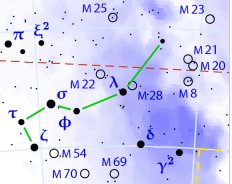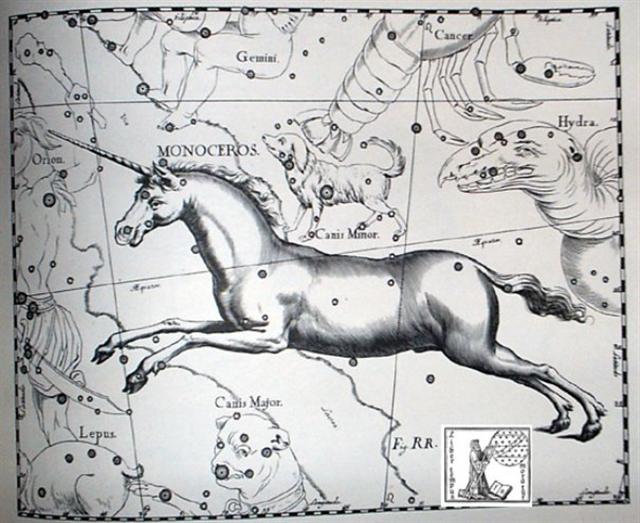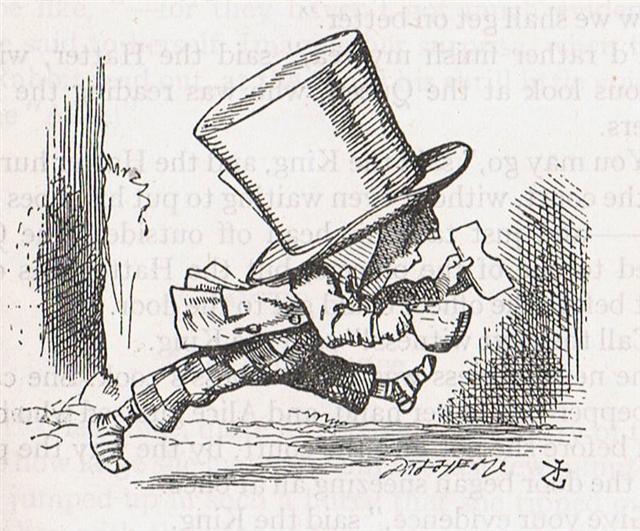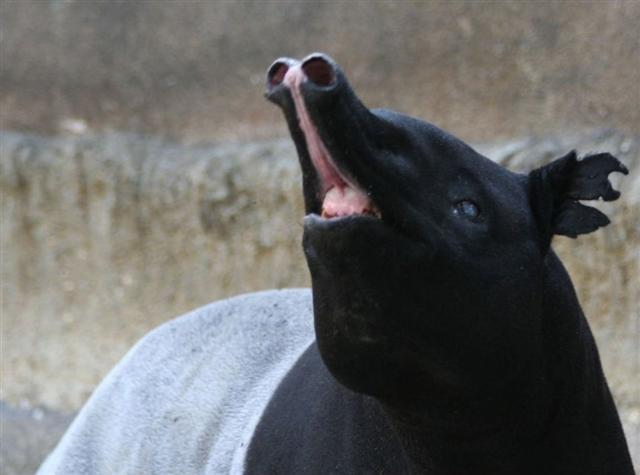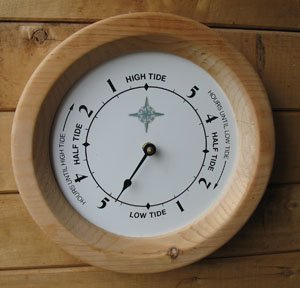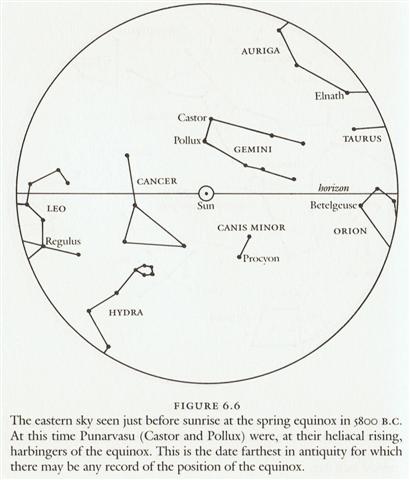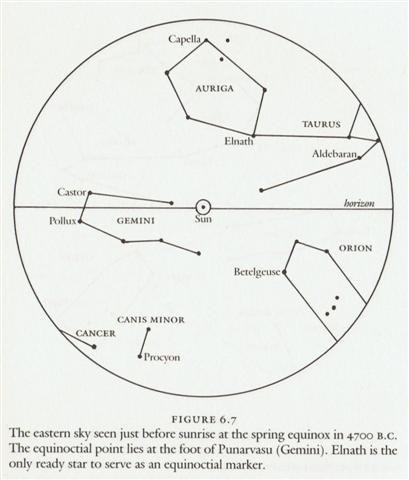The outstretched (hora) right front paw of the White Tiger was at the opposite side of the sky compared to the South Dipper, at the curved (paupau) neck of the Green Serpent:
Outstretched was also the arm at Mebsuta (ε Gemini) in the day before Sirius. In contrast, at left in Ga2-7 there appears to be a broken arm:
... During his descent the ancestor still possessed the quality of a water spirit, and his body, though preserving its human appearance, owing to its being that of a regenerated man, was equipped with four flexible limbs like serpents after the pattern of the arms of the Great Nummo. The ground was rapidly approaching. The ancestor was still standing, his arms in front of him and the hammer and anvil hanging across his limbs. The shock of his final impact on the earth when he came to the end of the rainbow, scattered in a cloud of dust the animals, vegetables and men disposed on the steps. When calm was restored, the smith was still on the roof, standing erect facing towards the north, his tools still in the same position. But in the shock of landing the hammer and the anvil had broken his arms and legs at the level of elbows and knees, which he did not have before. He thus acquired the joints proper to the new human form, which was to spread over the earth and to devote itself to toil ...
The extended (hora) arm of the White Tiger should remind us of the Forearm (Al Dhirā') of the Arabs. The Gemini twins were straight above the Tiger's right front paw. ... Mebsuta is from Al Mabsutāt, the Outstretched, from its marking the extended paw of the early Arab Lion, but now it is on the hem of Castor's tunic ...
At the time of rongorongo there were 193 (July 12) - 181 (June 30) = 12 days from Sirius to Castor (Beaver), because the precession had pushed Castor ahead while Sirius had stood still in the calendar for the Sun. There were 72 (= 360 / 5) days from Bharani to Castor, from May 1 to July 12, and at the time when heliacal Aldebaran was at 0h the star of the Beaver would have risen with the Sun in day 193 (July 12) - *68 = 125 (*MAY 5) with Bharani in day 125 - 72 = 53 (*FEBRUARY 22). Could the idea of an extended forearm have originated from contemplating the effects of the precession?
... The leap day was introduced as part of the Julian reform. The day following the Terminalia (February 23) was doubled, forming the 'bis sextum - literally 'double sixth', since February 24 was 'the sixth day before the Kalends of March' using Roman inclusive counting (March 1 was the 'first day') ...
Counting back in time to when Castor once would have had the same position in the year as Bharani we will find the year to be around 71 * 72 - 1842 A.D. = 3270 B.C.
.. This pot depicts one of the Hero Twins (One-Ahaw in the Classic texts and One-Hunaphu in the K'iche' Popol Vuh) and a great bird who is trying to land in a huge ceiba tree heavy with fruit. This mythical bird is Itzam-Yeh, Classic prototype of Wuqub-Kaqix, 'Seven-Macaw', of Popol Vuh fame. In that story, in the time before the sky was lifted up to make room for the light, the vainglorious Seven-Macaw imagined himself to be the sun. Offended by his pride, the Hero Twins humbled him by breaking his beautiful shining tooth with a pellet from their blowgun. This pot shows One-Ahaw aiming at the bird as he swoops down to land in his tree. As Itzam-Yeh lands on his perch, the text tells us he is 'entering or becoming the sky'. This particular 'sky-entering' is not the one mentioned in the Palenque text. It is the final event that occurred in the previous creation before the universe was remade. Before the sky could be raised and the real sun revealed in all its splendor, the Hero Twins had to put the false sun, Itzam-Yeh, in his place. If the date on this pot corresponds to that pre-Columbian event, as we believe it does, then Itzam-Yeh was defeated on 12.18.4.5.0 1 Ahaw 3 K'ank'in (May 28, 3149 B.C.). After the new universe was finally brought into existence, First Father also entered the sky by landing in the tree, just as Itzam-Yeh did ... 3270 B.C. - 3149 B.C. = 121 (= 11 * 11) precessional years, and 121 / 71 = ca 1.7 or about 2 days was equal to the distance from Castor (*113.4) to α Monocerotis (*115.4). At the time of Ain φ Sagittarii would have been at the Full Moon 64 precessional days earlier than at the time of rongorongo, viz. in day 300 (OCTOBER 17). At the time of rongorongo this happened in day 364 (December 30) = 181 (heliacal Sirius) + 366 / 2. Significantly the Chinese pointed to the Unicorn (Monoceros) at their South Dipper station.
Sirius marked the greatest of all the tara points - like a single horn in front for the new Sun Horse (the old one seems to have disappeared at Auriga). And remarkably this brightest of all the nighttime stars stood firm in the calendar in spite of the precession, keeping perfect pace with the Sun: ... The Sothic cycle was based on what is referred to in technical jargon as 'the periodic return of the heliacal rising of Sirius', which is the first appearance of this star after a seasonal absence, rising at dawn just ahead of the sun in the eastern portion of the sky. In the case of Sirius the interval between one such rising and the next amounts to exactly 365.25 days - a mathematically harmonious figure, uncomplicated by further decimal points, which is just twelve minutes longer than the duration of the solar year ... On Easter Island one of the names for Sirius was Te Pou (pillar, pole, etc), perhaps because it was not affected by the precession - this star pillar stood unmoved in the flow of time: ... pou meaning column, pillar or post of either stone or wood. Sometimes the word is applied to a natural rock formation with postlike qualities which serves as an orientation point. The star Sirius is called Te Pou in Rapanui and functions in the same way ...  Te Pou (Sirius) was in contrast to Puna pau ... a small natural well near the quarry where the 'hats' (pukao) were made; it was so called because only a little water could be drawn from it every day and it ran dry very soon ...
... the seasonal cycle, throughout the ancient world, was the foremost sign of rebirth following death, and in Egypt the chronometer of this cycle was the annual flooding of the Nile. Numerous festival edifices were constructed, incensed, and consecrated; a throne hall wherein the king should sit while approached in obeisance by the gods and their priesthoods (who in a crueler time would have been the registrars of his death); a large court for the presentation of mimes, processions, and other such visual events; and finally a palace-chapel into which the god-king would retire for his changes of costume ...
... Pliny wants to assure us that 'the whole sea is conscious of the rise of that star, as is most clearly seen in the Dardanelles, for sea-weed and fishes float on the surface, and everything is turned up from the bottom'. He also remarks that at the rising of the Dog-Star the wine in the cellars begins to stir up and that the still waters move ...
... 'Tell us a story!' said the March Hare. 'Yes, please do!' pleaded Alice. 'And be quick about it', added the Hatter, 'or you'll be asleep again before it's done.' 'Once upon a time there were three little sisters', the Dormouse began in a great hurry: 'and their names were Elsie, Lacie, and Tillie; and they lived at the bottom of a well ...
Sirius was like Crow who brought fresh drinking water (in contrast to the always thirsty Raven): ... There was no water in the village. The lakes and rivers were dry. Raven and Crow, two young girls who were having their first menstrual courses, were told to go and draw water from the ocean. Finding the journey too long, Raven decided just to urinate into her basket-bucket. She decieved no one and was severly scolded. Crow returned much later but with drinking water. As a punishment, Raven was condemned never to find water in the summer; only in winter would she find something to drink. For that reason the Raven never drinks during the hot months; she speaks with a raucous voice because of her dry throat ... The Chinese Well station was not only at μ Gemini (Tejat Posterior) but also at Canopus. And the tapir had no long hard horn.
... The Arabs in the desert regarded it [Alcor] as a test of penetrating vision; and they were accustomed to oppose 'Suhel' to 'Suha' (Canopus to Alcor) as occupying respectively the highest and lowest posts in the celestial family. So that Vidit Alcor, et non lunam plenum, came to be a proverbial description of one keenly alive to trifles, but dull of apprehension for broad facts ... ... The Arabs preserved a name for Canopus - besides calling the star Kalb at-tai-man ('heart of the south') ... Suhail el-wezn, 'Canopus Ponderosus', the heavy-weighing Canopus, a name promptly declared meaningless by the experts, but which could well have belonged to an archaic system in which Canopus was the weight at the end of the plumb line, as befitted its important position as a heavy star at the South Pole of the 'waters below' ... ... The Pirt-Kopan-noot tribe of Australia have a legend of a Lost Pleiad, making this the queen of the other six, beloved by their heavenly Crow, our Canopus, and who, carried away by him, never returned to her home ...
... The Pythagoreans make Phaeton fall into Eridanus, burning part of its water, and glowing still at the time when the Argonauts passed by. Ovid stated that since the fall the Nile hides its sources. Rigveda 9.73.3 says that the Great Varuna has hidden the ocean. The Mahabharata tells in its own style why the 'heavenly Ganga' had to be brought down. At the end of the Golden Age (Krita Yuga) a class of Asura who had fought against the 'gods' hid themselves in the ocean where the gods could not reach them, and planned to overthrow the government. So the gods implored Agastya (Canopus, alpha Carinae = Eridu) for help. The great Rishi did as he was bidden, drank up the water of the ocean, and thus laid bare the enemies, who were then slain by the gods. But now, there was no ocean anymore! Implored by the gods to fill the sea again, the Holy One replied: 'That water in sooth hath been digested by me. Some other expedient, therefore, must be thought of by you, if ye desire to make endeavour to fill the ocean ... Canopus was 6 days before Sirius and represented its contrast, viz. ebb (pau). ... the Egyptian calendar lost about one day every four years relative to the Gregorian calendar. It is therefore sometimes referred to as the wandering year (Latin: annus vagus), as its months rotated about a third of the way through the solar year each century. Ptolemy III's Canopus Decree attempted to correct this through the introduction of a sixth epagomenal day every four years but the proposal was resisted by the Egyptian priests and people and abandoned until the establishment of the Alexandrian or Coptic calendar by Augustus ... The tides shifted twice in a day and Sirius followed Canopus twice in a day, first at the Sun and then at the other side of the year at the Full Moon.
... The evening of 23 June, St. John's Eve, is the eve of celebration before the Feast Day of Saint John the Baptist. The Gospel of Luke (Luke 1:36, 56-57) states that John was born about six months before Jesus; therefore, the feast of John the Baptist was fixed on 24 June, six months before Christmas Eve ...
... 'Who are you talking to?' said the King, coming up to Alice, and looking at the Cat's head with great curiosity. 'It's a friend of mine - a Cheshire-Cat,' said Alice: 'allow me to introduce it.' 'I don't like the look of it at all,' said the King: 'however, it may kiss my hand, if it likes.' 'I'd rather not,' the Cat remarked. 'Don't be impertinent,' said the King, 'and don't look at me like that!' He got behind Alice as he spoke. 'A cat may look at a king,' said Alice. 'I've read that in some book, but I don't remember where.' 'Well, it must be removed,' said the King very decidedly: and he called to the Queen, who was passing at the moment, 'My dear! I wish you would have this cat removed!' The Queen had only one way of settling all difficulties, great or small. 'Off with his head!' she said without even looking around ...
... The manner of his death can be reconstructed from a variety of legends, folk-customs and other religious survivals. At mid-summer, at the end of a half-year reign, Hercules is made drunk with mead and led into the middle of a circle of twelve stones arranged around an oak, in front of which stands an altar-stone; the oak has been lopped until it is T-shaped. He is bound to it with willow thongs in the 'five-fold bond' which joins wrists, neck, and ankles together, beaten by his comrades till he faints, then flayed, blinded, castrated, impaled with a mistletoe stake, and finally hacked into joints on the altar-stone. His blood is caught in a basin and used for sprinkling the whole tribe to make them vigorous and fruitful. The joints are roasted at twin fires of oak-loppings, kindled with sacred fire preserved from a lightning-blasted oak or made by twirling an alder- or cornel-wood fire-drill in an oak log. The trunk is then uprooted and split into faggots which are added to the flames. The twelve merry-men rush in a wild figure-of-eight dance around the fires, singing ecstatically and tearing at the flesh with their teeth. The bloody remains are burnt in the fire, all except the genitals and the head. These are put into an alder-wood boat and floated down the river to an islet; though the head is sometimes cured with smoke and preserved for oracular use. His tanist succeeds him and reigns for the remainder of the year, when he is sacrificially killed by a new Hercules ... ∞ The Gemini twins were anciently at the spring equinox, one standing in winter and one in summer. But that was a very long time ago: ... In Hindu legend there was a mother goddess called Aditi, who had seven offspring. She is called 'Mother of the Gods'. Aditi, whose name means 'free, unbounded, infinity' was assigned in the ancient lists of constellations as the regent of the asterism Punarvasu. Punarvasu is dual in form and means 'The Doublegood Pair'. The singular form of this noun is used to refer to the star Pollux. It is not difficult to surmise that the other member of the Doublegood Pair was Castor. Then the constellation Punarvasu is quite equivalent to our Gemini, the Twins. In far antiquity (5800 B.C.) the spring equinoctial point was predicted by the heliacal rising of the Twins (see fig. 6.6). By 4700 B.C. the equinox lay squarely in Gemini (fig. 6.7).
|
|||||||||||||||||||||||||||||||||||||||||||||||||||||||||||||||||||||||||||||||||||||||||||||||||||||||||||||||||||||||||||||||||||||||||||||||||||||||||||||||||||||||||||||||||||||||||||||||||||||||||||||||||||||||||||||||||||||||||||||||||||||||||||||||||||||||||||||||||||||||||||||||||||||||||||||||||||||||||||||||||||||||||||||||

